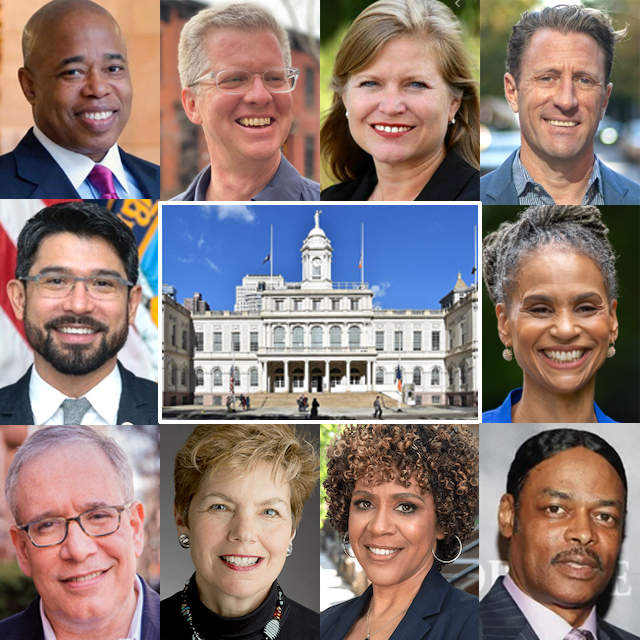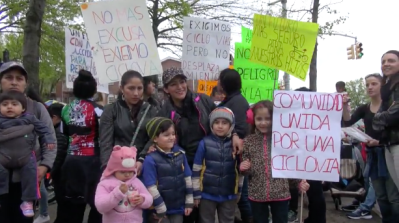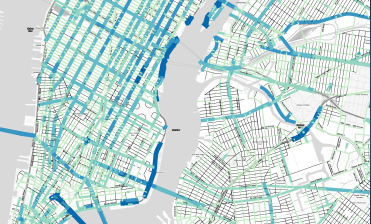DECISION 2021: Mayoral Hopefuls Plan for Our COVID-Socked Streets
Streetsblog asked 11 candidates who would lead the city to expound on their vision for street safety. Ten stepped up. Part One of their answers.


Permanent “open streets.” “Safe routes to parks” that connect communities to open space via safe-cycling and traffic-calming infrastructure. “Complete Streets” that discourage reckless driving.
These are some ideas for the city’s streetscape forwarded by a diverse field of Democratic mayoral candidates — 11 and counting — 10 of whom responded to a questionnaire from Streetsblog. With the coronavirus pandemic having decimated city budgets and upended planning, the 2021 mayoral election is shaping up to be the most important one since the 2001 contest, which fell right after the 9/11 attacks.
This is the first of daily rollouts of the candidates’ thoughtful and often-voluminous answers to our questions, which should provide safe-streets activists with a roadmap of where the hopefuls stand on our issues. At the end of the series, we’ll post all seven installments in one place for easy reference.
First, let’s meet the candidates (in alphabetical order). [These mini-bios won’t appear in future installments.]:
Eric Adams: The Brooklyn borough president, a former cop, launched his candidacy with a poignant video tying his life story of growing up poor and Black in Queens with ideas about police reform and public safety.
Shaun Donovan: An accomplished technocrat, Donovan served as commissioner for Housing Preservation and Development under Mayor Bloomberg and for eight years in the Obama administration, first as secretary of the Department of Housing and Urban Development then as director of the Office of Management and Budget.
Kathryn Garcia: Garcia, Mayor de Blasio’s Sanitation commissioner, resigned several months ago in order to launch her bid as a critic of her old boss. She says that “the city needs a crisis manager.”
Zach Iscol: An Iraq combat veteran and entrepreneur, Iscol touts his experience managing not-for-profit efforts on COVID and veterans’ mental health as evidence of his leadership abilities.
Ray McGuire: A Wall Street financier who worked his way up from humble origins, McGuire believes that his business experience could aid the city’s revival. McGuire declined to answer our questionnaire.
Carlos Menchaca: Council Member Menchaca represents Sunset Park, among other Brooklyn neighborhoods, and promises a “bold, progressive plan” on issues such as policing, economic equality, immigration, and systemic racism.
Dianne Morales: An executive with experience at big social-service not-for-profits, Morales wants to “divest from the police” in order to “invest in the people,” among other progressive nostrums.
Scott Stringer: The city’s comptroller (an independently elected office with oversight of the municipal budget and pension funds) talks about using his managerial skills to advance goals such as more affordable housing and retirement security and has promoted bike lanes and other safe-streets measures.
Loree Sutton: A psychiatrist and former brigadier general, Sutton fashions herself as a “champion for the city” who can apply skills learned managing complex organizations in order to execute “large-scale operations under life and death conditions.”
Maya Wiley: Wiley worked for de Blasio as his counsel, on issues such as civil and immigrant rights, women- and minority-owned business contracts and universal broadband access. Now a professor at the New School, she has gained a national following as an MSNBC legal analyst.
Isaac Wright Jr.: An attorney who was wrongly incarcerated, and is running on a platform of criminal-justice reform, properly funding public schools, and ensuring every city resident has a path toward home ownership.
Now, here’s our first question:
The Open and Restaurant Streets programs repurposed curbside space for public use instead of the free storage of privately owned cars. Would you make such programs permanent — and do you have other ideas for repurposing street space for public benefit?

We also must do more to reallocate curbside space for public use. I would establish minimum allotments for parklets and bike corrals in each community district, providing much needed resources for communities. The idea would be to baseline the number of parklets and corrals available to each community district and that each community district would then direct where they would be allocated.
I also would create a “safe routes to parks” program that connects communities to open space through dedicated safe cycling infrastructure and traffic calming investments. I’m also committed to expanding bike share service across the city by introducing competition among private providers. We must provide mobility options for all New Yorkers, and create safe street infrastructure where daylighting and/or protected bike lanes are added as a need.

Open streets cannot be a fad; they are a pathway to a more equitable transportation infrastructure in the city because all New Yorkers deserve the social, economic and environmental benefits of permanent open streets. I will lead the effort to reimagine the New York City streetscape for the 21st century, reduce the city’s reliance on cars, expand bus and bike lanes, and end traffic violence. We need to put people, not cars, at the center of all transportation conversations and projects.
Specifically, I have worked extensively to do this using “Complete Streets” models at the neighborhood and regional scale as HPD Commissioner and HUD Secretary, and will get reckless, unsafe drivers off our streets and reduce illegal speeding by cars and trucks. With more strategic and consistent enforcement, and improved street design, we can make streets safer and stop traffic violence in the city.
So far this year more than 210 people have been killed in traffic in New York City. As a parent, policymaker and architect I refuse to tolerate people dying in the crosswalk as an unavoidable part of city living. The evidence is overwhelming: two of the biggest contributors to unsafe streets are speeding and unsafe drivers, and that’s where I will focus to start. Change on our streets is a matter of leadership and commitment and as Mayor I will prioritize and sustain this effort.

Our streets and sidewalks today are a losing battle between competing uses, and we must ensure that our public spaces serve the public first.
I’m proposing “Complete Streets” in all five boroughs that prioritize pedestrians, bicyclists and transit riders.
I also support the use of curbside space for public amenities including containerized trash and recycling set-out — to keep our sidewalks clean and passable.

Since open streets and restaurants, Citi Bike, and the ZipCar car-share program occupy street space and we have numerous outdated parking restrictions across the city, it is incumbent upon the next mayor and the DOT to do a comprehensive review of street-parking regulations and ensure we also have adequate space for the safe operation and parking of vehicles — these are not mutually exclusive aims.
In the near term, one of the most important things we need to be doing for the city right now is revitalizing businesses, especially restaurants and tourism. In 2019, the tourism industry supported more than 400,000 jobs and brought in $7 billion in tax revenue. This year, the Comptroller’s Office projected a loss of at least $1.5 billion in taxable revenue.
At a time when New York is already being faced with difficult budgeting decisions, we must do everything in our power to bring restaurants and tourism back to full strength. Open restaurants and streets are good steps in the right direction. The fact that the city has already committed to making its initially temporary outdoor dining program permanent is a testament to its popularity and efficacy. City officials estimate that its implementation has saved 90,000 jobs.
But there’s still room for progress: The city’s adherence to current “no standing” zone regulations and other outdated restrictions means that some restaurants are unable to participate in the program.
Beyond the loss of revenue, part of what makes New York City the greatest city in the world is its vibrancy and walkability. Even once we weather this pandemic we need to do everything in our power to make New York both a livable city and the premier tourist destination in the county. A big part of that will be more car free spaces. New York City’s Community Air Survey has studied the issue and found that car free spaces are effective in improving air quality, most especially through a reduction in nitric oxide.

Of course, we should continue to analyze the implementation of open streets, particularly how restaurants operate in public spaces to ensure safety for diner and pedestrians, while creating more open space for the public use and providing additional revenue opportunities for restaurants and important job opportunities for New Yorkers.
Restaurants are just the beginning. Artists are struggling to find space to create and perform their art. We can expand the use of public space to include artists that will draw safe outdoor activities, even in winter. It will be a while before Broadway shows open up and artists need a place to create and harness their craft until we can reopen again. This too should be permanent in our neighborhoods.

When there are tables and chairs in a public space, it generates a greater sense of community and sends a message that people are welcome. Mega-corporations and large retailers understand this and have successfully leveraged their power to get City Hall to make changes that are good for their businesses.
As mayor I will do this for every neighborhood, not with focus on commercialization, but because our streets are where we meet our neighbors, celebrate our cultures and connect with our community — and because local, accessible public gathering spaces are key components of healthy, thriving communities.

In my administration, curb and street space throughout the five boroughs will be repurposed for wider sidewalks, street seating, bus shelters, bike parking, Citi Bike docking stations, public restrooms, improved garbage collection, playstreets and playgrounds, bus lanes, bike lanes, plazas, and much more.
Everyone in our city should have access to public space, clean air, and fast, reliable, sustainable transportation. It’s time we reclaim our streets for the people of this city and build stronger and healthier neighborhoods and communities.

In principle, I favor facilitating public space for the benefits generated by the Open and Restaurant Streets program; to build upon current progress, I would engage in a systems approach to make sure we’re doing it in a fair, equitable, rational and effective way. One of the systemic problems we have is piecemeal, reactive approaches that address one narrow piece of a problem.
We need to take a step back, look at all of the moving and connected parts and design a holistic solution that is flexible enough to allow for ongoing adaptive changes and which sets the creative conditions for continued innovation.

Through my campaign’s “People’s Assemblies” process, I will ensure that my proposal to improve this program will be based on participation and feedback by the communities who will be impacted by this program.
There are a number of considerations that will guide my thinking on how to make this program more effective. This will include:
- Making implementation more equitable. While Open Streets has been a success, the program has not reached all New Yorkers. Currently, only 37 percent of the city’s residents live within one mile of an open street. Infrastructure investment, including access to open space, is a racial justice issue. An equitable Open Streets plan helps address a legacy of infrastructural inequity.
- Identifying ways to help small businesses be successful within the program.
- Identifying opportunities for restaurants in COVID impacted communities for curbside design and build out.
- Improving maintenance and management of designated open streets. For example, the success of a car-free Times Square provides a blueprint for low-cost maintenance that can be replicated across the city.

Longer term, my goal as mayor will be to get the city to a place where using your car is a luxury, not a necessity. Too often, working people don’t have the option to take public transit and are forced to use cars. As mayor, I’ll take a lead in addressing the negative impact that historical redlining still has on our public transit and infrastructure, working to expand access to public transit in so many neighborhoods that are currently cut off. There’s a much larger conversation to be had here about transitioning our city toward the future, and the open and restaurant streets programs are just the first step.

